1941 Wheat pennies aren’t particularly rare, thanks to a massive mintage of over 1 billion coins. While most circulated examples have little more than face value due to heavy wear, uncirculated or high-grade coins, as well as those with errors, can be quite collectible and valuable.
Even after 80+ years, there are still many 1941 pennies out there, so condition and variety are key when evaluating their worth.
1941 Wheat Penny Value Chart
| Condition | 1941 (P) No Mint Mark | 1941 D (Denver) | 1941 S (San Francisco) |
|---|---|---|---|
| Good (G-4) | $0.18 | $0.18 | $0.18 |
| Very Good (VG-8) | $0.21 | $0.21 | $0.21 |
| Fine (F-12) | $0.23 | $0.23 | $0.35 |
| Very Fine (VF-20) | $0.35 | $0.59 | $0.59 |
| Extra Fine (EF-40) | $0.71 | $1.20 | $1.20 |
| About Uncirculated (AU-50) | $1.82 | $3.50 | $3.50 |
| Mint State (MS-60) | $2.41 | $4.80 | $4.80 |
| Mint State (MS-63) | $3.50 | $6.05 | $6.05 |
| Proof (PR-63)* | $48 | / | / |
📝 *Proof coins were only struck in Philadelphia in 1941, hence no values for Denver or San Francisco proofs.
History of the 1941 Wheat Penny
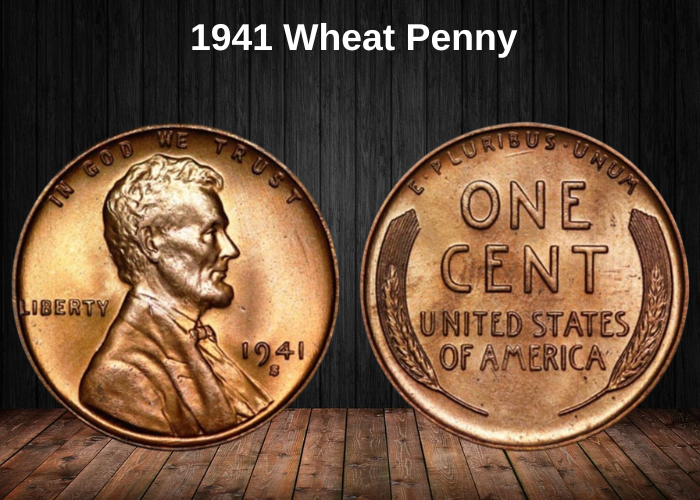
The Lincoln cent featuring wheat stalks on the reverse was first introduced in 1909 to commemorate the 100th anniversary of Abraham Lincoln’s birth, honoring one of America’s most admired presidents.
Due to the popularity of these coins among collectors, the U.S. Mint began producing proof versions in 1936, intended specifically for hobbyists. This marked the first time in U.S. history that coins were minted solely for collecting purposes rather than everyday transactions.
1941 Wheat Penny Varieties and Mintage Numbers
| Mint Location | Coin Type | Mintage |
|---|---|---|
| Philadelphia | 1941 (no mint mark) cent | 887,018,000 |
| Philadelphia | 1941 proof cent | 21,100 |
| San Francisco | 1941 S cent | 92,360,000 |
| Denver | 1941 D cent | 128,700,000 |
| Total | — | 1,118,099,100 |
A Historic Coin in a Time of Conflict
After 32 years of Lincoln cent production, the 1941 coins marked the beginning of the WWII-era issues, as the U.S. entered the war following the attack on Pearl Harbor.
These cents were among the last to be made from copper, before the Mint shifted to zinc-coated steel in 1943 to conserve copper for the war effort. Although 1941 pennies resemble others in the Wheat series, their timing gives them unique historical significance.
Despite their high mintage figures, especially from the Philadelphia Mint (which had the sixth highest production run for the series that year), the story behind these coins, along with their link to a pivotal moment in U.S. history, makes them a favorite among both beginner and seasoned collectors.
Features of the 1941 Wheat Penny
The 1941 Wheat cents belong to one of the most iconic and beloved coin series in American history. First introduced in 1909, these pennies were part of President Theodore Roosevelt’s initiative to enhance the artistic quality of U.S. coinage. Designed by Victor David Brenner, the obverse—featuring a portrait of Abraham Lincoln—remains in use to this day. Over the years, however, the reverse design has evolved, reflecting different historical moments and themes chosen by the U.S. Mint.
The obverse of the 1941 Wheat Penny

Like other Lincoln cents, the 1941 Wheat penny features a right-facing portrait of Abraham Lincoln on the obverse, designed by Victor D. Brenner. The word “LIBERTY” appears to the left, just behind Lincoln’s shoulder, while the date “1941” is positioned on the right. If the coin was minted in Denver or San Francisco, a small “D” or “S” mint mark appears just beneath the date.
All 1941 pennies also include Brenner’s initials, “V.D.B.”, subtly engraved on the lower edge of Lincoln’s bust. The design is topped with the national motto, “IN GOD WE TRUST,” curving along the upper rim of the coin.
The reverse of the 1941 Wheat Penny

The 1941 pennies belong to the Wheat series, which means their reverse features two stylized wheat stalks curving along the left and right edges. These frame four lines of bold text in the center:
ONE
CENT
UNITED STATES
OF AMERICA
Above the main inscription is the Latin motto “E PLURIBUS UNUM,” arched along the top rim.
Interestingly, Victor D. Brenner had originally proposed a reverse design featuring tree branches. However, this was considered too similar to French coinage at the time. As a result, Mint Director Frank Leach requested an alternative design, leading to the iconic wheat stalks.
Another early issue involved Brenner’s initials, which he had prominently displayed on the reverse. Due to public backlash, they were removed shortly after the coin’s release. They wouldn’t return until 1918, when they were discreetly added to the obverse—a feature that is present on all 1941 cents.
| 1941 Wheat Penny Details | |
| Coin weight | 3.11 g (0.10970 ounces) |
| Shape | Round |
| Compound | An alloy of 95% copper with zinc or tin |
| Coin thickness | 1 mm (0.03937 inches) |
| Coin diameter | 19.05 mm (1.75 inches) |
| Edge | Plain |
| Face value | One cent ($0.01) |
Other features of the 1941 Wheat Penny
The 1941 Wheat penny is a round, one-cent coin struck from a copper alloy. It measures 19.05 mm (0.75 inches) in diameter and is 1 mm (0.039 inches) thick. With a plain edge, this coin weighs 3.11 grams (0.1097 ounces).
1941 Wheat Penny Grading
The coin grading scale for collectible coins ranges from Basal State-1 to Mint State-70 (MS70), with higher grades indicating better preservation and fewer imperfections. The most valuable 1941 Wheat pennies are those graded up to MS68, which represent the finest known examples of this coin.
Below is a simplified breakdown of the grading scale:
| Grade | Description |
|---|---|
| 1 | Basal State-1 |
| 2 | Fair |
| 3 | Very Fair |
| 4–6 | Good |
| 7–10 | Very Good |
| 12–15 | Fine |
| 20–30 | Very Fine |
| 40 | Extremely Fine |
| 50 | About Uncirculated |
| 60 | Mint State |
| 65 | Gem Mint State |
| 70 | Perfect Mint State |
To determine the exact value of your 1941 penny, it’s essential to understand its grade. We recommend checking our coin grading guides to assess your coin accurately and discover its true market worth.
1941 Wheat Penny Value Guides
The Philadelphia Mint was responsible for producing the majority of the 1,118,099,100 pennies struck in 1941. It minted nearly 900 million regular circulation coins, in addition to a small number of proof coins made specifically for collectors. In comparison, the Denver and San Francisco Mints had significantly lower production figures that year.
1941 No Mint mark Wheat Penny Value
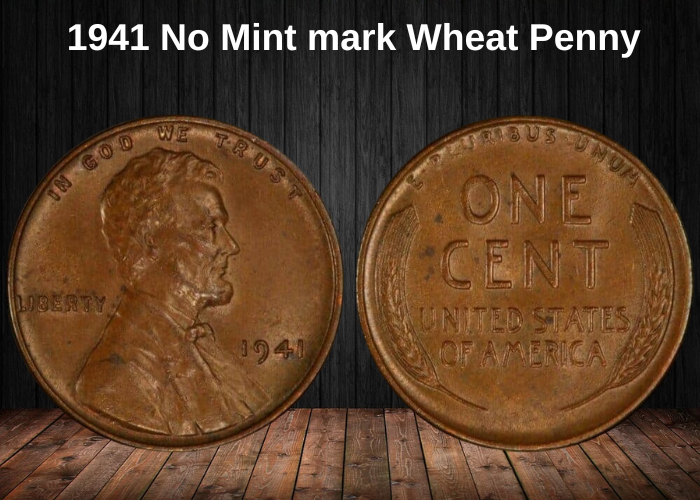
The 1941 Philadelphia Wheat penny had a high mintage of 887,018,000, which contributes to its relatively moderate value in today’s market. Here’s a breakdown of how the prices vary based on the appearance and grade of the coins:
- Brown Coins: These range from $0.05 to $3.60, depending on their condition.
- Red-Brown Coins: These tend to be more expensive, ranging from $3.90 to $15.
- Red Coins: These are the most sought after, with prices increasing significantly based on their grade:
- MS 63: Around $6.25.
- MS 64: Around $9.
- MS 65: Around $12.
- MS 66: Around $30.
- MS 67: Around $170.
- MS 68 Red Coins: These are exceptionally rare and highly valuable, with prices starting at $9,500.
Due to the high mintage, there are many coins available, but those in higher grades (especially those with red toning) can still be valuable.
1941 proof Wheat Penny Value
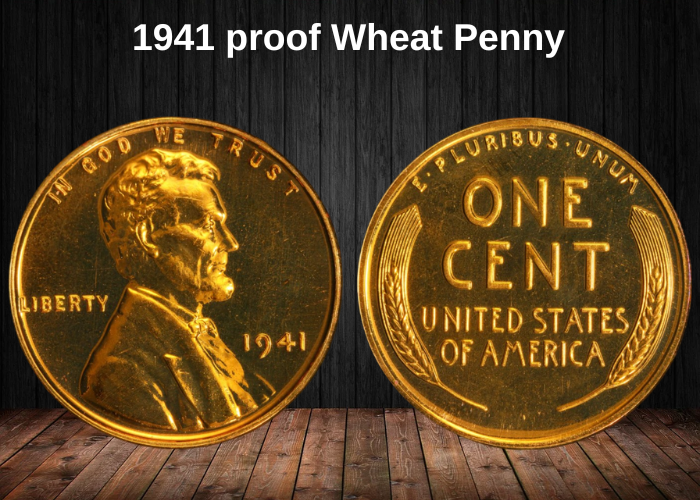
The 1941 proof pennies from the Philadelphia Mint, with a mintage of only 21,100 coins, are highly sought after by collectors due to their rarity. Here’s a breakdown of their prices based on the condition and color:
- Brown Proof Pennies: These are the least desirable among collectors, with prices ranging from $15.75 to $90 depending on the quality.
- Red-Brown Proof Pennies: These are slightly more expensive, ranging from $22 to $200.
- Red Proof Pennies: These are the most valuable, especially when graded higher. Prices for PR 67-graded coins can range from $2,000 to $2,400 on average, with some rare specimens fetching even higher prices.
- PR 61-graded Red Proof Pennies: Priced around $42.
- PR 62-graded Red Proof Pennies: Priced around $50.
- PR 63-graded Red Proof Pennies: Priced around $80.
- PR 64-graded Red Proof Pennies: Priced around $110.
- PR 65-graded Red Proof Pennies: Priced around $175.
- PR 66-graded Red Proof Pennies: Priced around $475.
The PR 67-graded red coins are the most collectible and can be worth as much as $12,500 due to their exceptional condition and rarity.
1941 D Wheat Penny Value

The 1941 D pennies, with a mintage of 128,700,000, are relatively common and, as a result, have a more moderate value compared to rarer years. Here’s a breakdown of their prices based on the condition and color:
- Brown 1941 D Pennies: These are the least expensive, typically priced between $1.75 and $3.60.
- Red-Brown 1941 D Pennies: These are a bit more expensive, with prices ranging from $2.40 to $15.
- Red 1941 D Pennies: These can cost anywhere from $9 to $120, depending on their grade and toning.
- Exceptional Pieces: Some rare high-grade coins, such as an MS 68-rated penny minted in 1941, can fetch significantly higher prices. For example, one sold for $6,600 in 2023.
The price range reflects the rarity and quality, with higher-grade and well-preserved red coins being the most valuable.
1941 S Wheat Penny Value
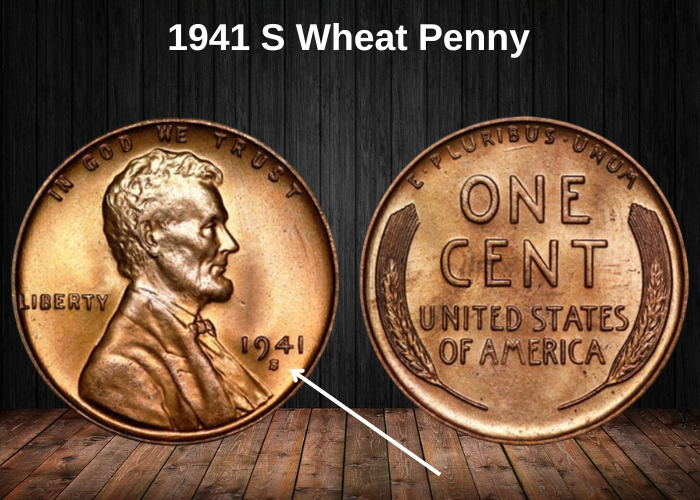
The 1941 S pennies, with a mintage of only 92,360,000, are relatively scarce compared to those minted in Philadelphia and Denver, but their prices are still quite moderate. Here’s a breakdown:
- Brown 1941 S Pennies: These are the most affordable, typically priced between $2 and $5.
- Red-Brown 1941 S Pennies: Slightly more expensive, with prices ranging from $3 to $15.
- Red 1941 S Pennies:
- MS 63 to MS 66: These higher-grade red coins are worth between $7 and $40.
- MS 67: The finest examples, graded MS 67, can reach up to $210 at auctions.
The relatively low mintage and quality grading have a strong influence on the value, especially for higher-grade red coins.
Rare 1941 Wheat Penny Error List
At the start of World War II, the U.S. Mint encountered supply shortages and logistical difficulties. In response, they had to come up with solutions to continue producing Wheat pennies despite these challenges. As a result, the minting process sometimes led to error coins. While these mistakes were undesirable for the Mint, they were a treat for collectors who valued these unique and rare pieces.
DDO
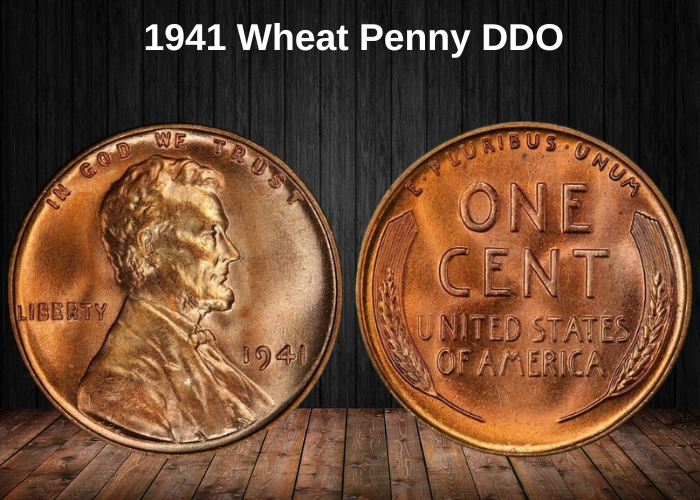
The double die obverse error is a well-known issue with some 1941 pennies. It happens when the die strikes the coin surface more than once, causing noticeable doubling on features such as LIBERTY and/or IN GOD WE TRUST.
These error coins are highly sought after by collectors, and their prices can vary widely depending on their condition. For example:
- Brown coins with this error can range from $80 to $500.
- Red-brown coins typically sell for between $225 and $780.
- For the 1941 DDO red pennies, prices can go from $275 to $2,400, depending on the coin’s grade.
Penny with digit shift
Error coins from the 1941 San Francisco mint are quite rare, but they do exist. These coins are identifiable by a slight shift in the minting, causing the last digit of the year, the number 1, to lean to the side. This error is highly sought after by collectors, and a 1941 Wheat cent with this specific error can fetch around $300 depending on its condition.
Penny on an experimental planchet

The 1941 pennies with this unusual imperfection are indeed rare and are considered experimental coins rather than traditional errors. These coins were produced during a time when the US Mint was experimenting with various metal alloys due to the increased demand for copper from the military during World War II.
These experimental pennies typically contain a lower percentage of copper compared to regular coins from the same year. Although they are not technically errors, their unique composition makes them highly collectible. Depending on their condition, these coins can be worth up to $600.
Where to sell your penny?
Now that you know the value of your penny, you might be wondering where to sell it. Don’t worry: here’s a guide to some of the best online platforms where you can easily sell your coins, along with their advantages and disadvantages.
Discover the best platforms for selling coins online (pros and cons).
FAQ about the 1941 Wheat Penny
1. How does the 1941 Wheat Penny reflect the economic conditions of the United States just before its entry into World War II?
The 1941 Wheat Penny was minted during a pivotal time in U.S. history, as the nation was still recovering from the Great Depression and was on the brink of entering World War II. The coin symbolizes a time of economic transition, where civilian needs were still dominating the economy, but there were growing preparations for the impending war. While the 1941 Wheat Penny itself did not reflect the urgency of wartime, it marks the final year of the pre-war economy before major shifts in U.S. production and materials occurred in response to the war effort. The U.S. Mint would soon transition to producing wartime coins, such as the steel cent in 1943, using materials previously dedicated to coinage.
2. What was the significance of the 1941 Wheat Penny in the larger context of the Wheat Cent series?
The 1941 Wheat Penny represents the penultimate year of the Wheat Cent series, which was introduced in 1909. Its design, featuring Abraham Lincoln on the obverse and wheat stalks on the reverse, is the last before the Mint transitioned to the Lincoln Memorial design in 1959. The coin’s design is part of a larger transition in U.S. coinage, marking the end of the Wheat Cent era as the Mint prepared for the monumental shift during the war years. Collectors often look at coins like the 1941 penny as they symbolize a specific moment in U.S. history and represent the final years before more modernized coinage designs.
3. What factors contribute to the value of the 1941 Wheat Penny, and why are high-grade examples particularly sought after by collectors?
The value of the 1941 Wheat Penny is influenced by its condition and rarity in certain grades. While the coin’s mintage was quite high, especially for the Philadelphia mint, high-quality examples are less common and command a premium price. In particular, collectors value well-preserved coins with minimal wear on Lincoln’s portrait and the wheat stalks, as these features are often the first to show signs of erosion. A Gem Uncirculated (MS65) example of the 1941 penny can command a much higher price than a coin in lower-grade conditions. The 1941-S (San Francisco) is relatively scarcer than the Philadelphia and Denver varieties, further increasing its value in top grades.
4. How does the 1941 Wheat Penny’s design influence its place in the history of U.S. coinage?
The 1941 Wheat Penny is a key piece in understanding the evolution of U.S. coin design. As part of the Wheat Cent series, it is the last example of the wheat reverse, which was used from 1909 until 1958. The design of the coin, which features Abraham Lincoln on the obverse and wheat stalks on the reverse, is recognized for its simplicity and elegance. The choice to feature wheat is symbolic of the nation’s agrarian past, aligning with a broader theme of American growth and prosperity. However, with the 1959 redesign (the Lincoln Memorial penny), the U.S. Mint moved towards a more iconic and modern image that would resonate with post-war America. The 1941 Wheat Penny, therefore, represents the final chapter of an important design era in U.S. currency history.
5. Why are certain mint marks (like the 1941-S) considered more valuable than others, and what makes the 1941-S especially significant in the context of the 1941 series?
While the 1941 Wheat Penny was minted in large quantities, the 1941-S (San Francisco) is rarer than both the Philadelphia and Denver versions. Only 40 million 1941-S pennies were minted compared to 887 million from Philadelphia and 100 million from Denver. Due to its relatively lower mintage and scarcity in high grades, the 1941-S is more valuable than its counterparts. The demand for San Francisco mint marks generally increases because they were often produced with more wear due to heavy circulation, so finding a well-preserved 1941-S penny becomes a more significant find for collectors.
6. How do error coins or die varieties, such as die cracks or repunched mint marks (RPMs), affect the value of a 1941 Wheat Penny?
Like other coins in the Wheat Cent series, the 1941 Wheat Penny is subject to various error coins and die varieties, which can add value to the coin for collectors seeking rare specimens. Some common varieties for the 1941 penny include:
- Repunched mint marks (RPMs): This error occurs when the mint mark was struck more than once, leading to a misaligned mint mark.
- Die cracks and die chips: These imperfections happen when the dies used to strike the coins wear or crack, resulting in errors on the coin’s design.
- Off-center strikes or double strikes: These rare occurrences can result in coins that are visually distinctive and desirable for collectors.
Coins with these errors, especially when they occur in high-grade specimens, can significantly increase their market value due to the rarity and collector interest in unique and imperfect coins.
7. How does the 1941 Wheat Penny fit into the broader historical context of coinage changes during the 1940s, especially with the shift to wartime production in the following years?
The 1941 Wheat Penny represents a last gasp of the pre-war era of U.S. coinage. Following this year, wartime needs would drastically change U.S. coin production. In 1942, the Mint began producing nickel coins with a different composition due to metal shortages caused by the war, and in 1943, the iconic steel cents were introduced. The 1941 penny marks a time of transition before the U.S. Mint began redirecting resources toward the war effort. The next few years would see massive changes in U.S. coinage, as materials were repurposed, and coin designs would later shift to reflect the nation’s post-war needs. As such, the 1941 Wheat Penny serves as a bridge between the classic era of American coinage and the wartime era that would soon follow.



















































